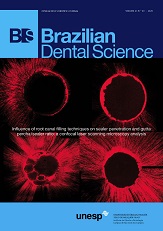Comparative study of some mechanical properties of cobalt chromium and polyether ether ketone thermoplastic removable partial denture clasps: an In-vitro Study
DOI:
https://doi.org/10.14295/bds.2020.v23i3.1935Abstract
Objective: was to evaluate the retentive force, fatigue resistance and deformity of clasps made from two materials cobalt chromium and poly ether et her ketone (PEEK). Material and Methods: sixteen models were fabricated, each one having lower 1st molar. Models were divided into two groups according to materials, group I (GI) for cobalt chromium (Co-Cr) and group II (GII) for PEEK. Each testing models and its clasps were mounted inside universal testing machine, the retention was measured by applying withdrawal force to it by this machine at 5 mm/min. The Fatigue resistance is measured by the reduction in retention through repeated insertion and removal cycles using robot a chewing simulator. Removal and insertion cycling of clasps was carried out for 360, 730, 1080, 1,440,2,116 and 2,880 cycles (corresponding to 3,6,9,12, 18 and 24 months of simulated clinical use of a RPD) to simulate the fatigue resistance test. Deformity was measured before and after each cycling using a digital micrometer. Statistical analysis was done by 2-way-ANOVA test to detect significance effects of each variable. Results: Retention and fatigue resistance, after 360,730, 1080, 1,440,2,116 and 2,880 cycles totally the difference between Co-Cr and PEEK groups was statistically non-significant (P = 0.0980>0.05) where (Co-Cr > PEEK). Deformation results, regardless to evaluation time, Co-Cr group recorded statistically significant higher deformation mean value than PEEK group (P = 0.008<0.05). Regardless to material group, deformation mean value changed non significantly by time (P = 0.2882> 0.05). Conclusion: PEEK clasps (1.0 mm in cross section diameter) engage 0.50 mm undercut provide sufficient retention nearly similar that of Co-Cr clasps.
Keywords
Flexible clasps; Polyether ether ketone, PEEK; Thermoplastic resin; Partial denture.
Downloads
References
McKenna G, Tada S, Woods N, Hayes M, DaMata C, Allen PF. Tooth replacement for partially dentate elders: A willingness-to-pay analysis. J Dent. 2016 Oct;53:51-6. DOI: 10.1016/j.jdent.2016.07.006
Rodrigues RC, Ribeiro RF, de Mattos Mda G, Bezzon OL. Comparative study of circumferential clasp retention force for titanium and cobalt-chromium removable partial dentures. J Prosthet Dent. 2002 Sep;88(3):290-6. PMID: 12426499
Chu CH, Chow TW. Esthetic designs of removable partial dentures.
Gen Dent. 2003 Jul-Aug;51(4):322-4. PMID:15055607
Eid DM el-S. A new material for partial dentures. An unbreakable thermoplastic resin paraformaldehyde and its Co-polymers. Egypt Dent J. 1971 Jan;17(1):1-22. PMID: 5281919
Singh K, Aeran H, Kumar N, Gupta N. Flexible thermoplastic denture base materials for aesthetical removable partial denture framework. J Clin Diagn Res. 2013 Oct;7(10):2372-3. doi: 10.7860/JCDR/2013/5020.3527..
Moldovan O, Rudolph H, Luthardt RG. Clinical performance of removable dental prostheses in the moderately reduced dentition: a systematic literature review. Clin Oral Investig. 2016 Sep;20(7):1435-47. DOI: 10.1007/s00784-016-1873-5
Zoidis P, Papathanasiou I, Polyzois G.The Use of a Modified Poly-Ether-Ether-Ketone (PEEK) as an Alternative Framework Material for Removable Dental Prostheses. A Clinical Report. J Prosthodont. 2016 Oct;25(7):580-584. DOI: 10.1111/jopr.12325
YAMAMOTO ETC, SATO TP, SILVA JMF2, BORGES ALS, UEMURA ES. Retentive force comparison between esthetic and metalclasps for removable partial denture. Braz Dent Sci, 2017; 20:87-93. DOI: 10.14295/bds.2017.v20i3.1431
Helal MA1, Baraka OA, Sanad ME, Ludwig K, Kern M. Effects of long-term simulated RPD clasp attachment/detachment on retention loss and wear for two clasp types and three abutment material surfaces. J Prosthodont. 2012 Jul;21(5):370-7. doi: 10.1111/j.1532-849X.2012.00844.x.
Fueki K, Ohkubo C, Yatabe M, Arakawa I, Arita M, Ino S, et al.
Clinical application of removable partial dentures using thermoplastic resin. Part II: Material properties and clinical features of non-metal clasp dentures. J Prosthodont Res. 2014 Apr;58(2):71-84. doi: 10.1016/j.jpor.2014.03.002
Tannous F1, Steiner M, Shahin R, Kern M. Retentive forces and fatigue resistance of thermoplastic resin clasps. Dent Mater. 2012 Mar;28(3):273-8. doi: 10.1016/j.dental.2011.10.016.
Abd-Elrahman IA, Helal MA, Saqar HM, Abas M. Evaluation of Fatigue Resistance of Acetal Resin and Cobalt–Chromium Removable Partial Denture Clasps. An In-vitro Study: Part 1. J Dent Oral Care Med. 2016; 2(3): 304. doi: 10.15744/2454-3276.2.304
Helal MA, Abd-Elrahman IA, Saqar HM, Salah A, Abas M. Evaluation of Acetal Resin and Cobalt–Chromium Clasp Deformation and Fatigue Resistance in Removable Partial Denture Clasps - An In Vitro Study. J Clin Res Dent 2018;1(1):1-5.
Alvarez S, Escuin T, Claramunt R , Ascaso C . Preliminary Study to Compare the Insertion/Removal Force of PEEK and Co-Cr Clasps. Open Journal of Dentistry and Oral Medicine 2017; 5.2:11 - 19. doi: 10.13189/ojdom.2017.050201.
Helal MA, Baraka OA, Sanad ME, Al-Khiary Y, Ludwig K, Kern M. Effect of clasp design on retention at different intervals using different abutment materials and in a simulated oral condition. J Prosthodont. 2014 Feb;23(2):140-5. doi: 10.1111/jopr.12072.
Arda T1, Arikan A. An in vitro comparison of retentive force and deformation of acetal resin and cobalt-chromium clasps. J Prosthet Dent. 2005 Sep;94(3):267-74. DOI: 10.1016/j.prosdent.2005.06.009
Muhsin SA, Hatton PV, Johnson A, Sereno N, Wood DJ.
Determination of Polyetheretherketone (PEEK) mechanical properties as a denture material. Saudi Dent J. 2019 Jul;31(3):382-391. DOI: 10.1016/j.sdentj.2019.03.005
Downloads
Additional Files
Published
How to Cite
Issue
Section
License
Brazilian Dental Science uses the Creative Commons (CC-BY 4.0) license, thus preserving the integrity of articles in an open access environment. The journal allows the author to retain publishing rights without restrictions.
=================




























